Skin Biopsy - NY Neurological Associates, PC
Is it small fiber neuropathy?
SMALL FIBER NEUROPATHY results from damage to the small unmyelinated nerve fibers that connect the pain receptors in the skin to the spinal cord and brain. The condition is diagnosed by demonstrating a reduction in the Epidermal Nerve Fiber Density (ENFD) in a skin punch biopsy. Unlike large fiber neuropathy, the diagnosis is easy to miss, as the sensory examination and EMG and Nerve Conduction Studies are usually normal.
The ENFD is reported as the average number of nerve fibers that cross the basement membrane at the dermal epidermal border, over a length of 1 mm. Making the correct diagnosis explains the symptoms, guides the evaluation for the underlying cause, and helps decide treatment.
Reasons for performing a Skin Biopsy in a patient
- To diagnose small fiber neuropathy.
- To follow progression of the neuropathy and the response to therapy.
- To participate in clinical trial studies where skin biopsy is used to assess normal or abnormal status of subjects.
- To provide documentation, for purposes of insurance coverage, to support recommended treatments.
- To confirm the diagnosis of sensory neuropathy in a patient with a compatible clinical presentation but normal electrodiagnostic studies.
- To differentiate between length-dependent neuropathy, ganglionopathy, or multifocal neuropathy.
- To diagnose vasculitic neuropathy that also involves the skin.
- To diagnosing amyloid neuropathy in a patient with amyloid skin deposits.
Biopsy sites
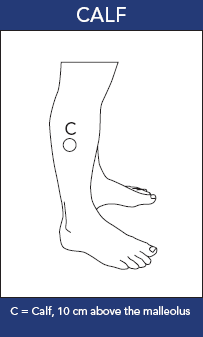
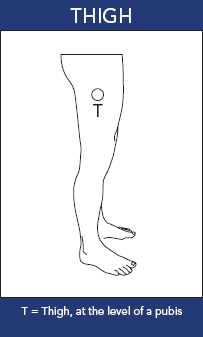
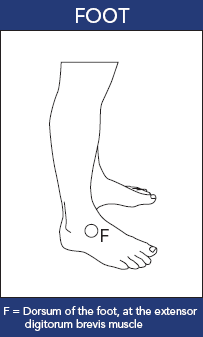
In suspected small fiber polyneuropathy, skin punch biopsies are routinely done at the lateral calf (10 mm above the lateral malleolus), the thigh (at the level of the pubis) and the dorsum of the foot (at the extensor digitorum brevis muscle). If focal or compressive neuropathy is suspected, the biopsy can be done at the affected region, and compared to the corresponding region in the unaffected foot, as control.
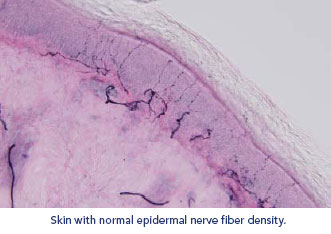
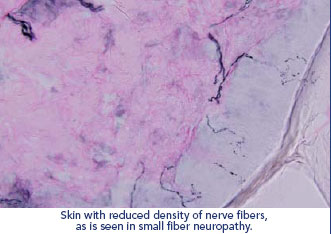
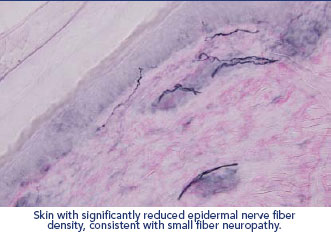
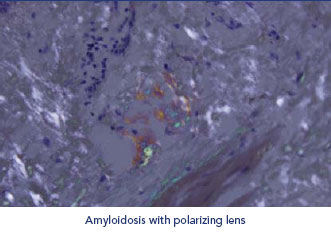
Processing a biopsy sample
This is an abbreviated description of the daily process from the day when we ship kits to the physician through the day that the report is released.
Day 1 – Customized fixative solution is compounded fresh each week. The fixative that is used to preserve the specimen & nerve fibers is made in the THERAPATH laboratory.
Day 2 – Priority overnight shipment of the testing kit is made to the physician’s office for the scheduled patient ENFD test.
Day 3 – Patient biopsy is taken and the medical office returns the specimen via priority overnight delivery for processing.
Day 4 – Specimen received, reviewed and the solution is changed to a another freshly compounded cryo-protectant solution that shields the tissue from becoming compromised during processing.
Day 5 – Specimen is frozen and then sectioned in thick, 50 micron sections by using a LEICA Crostat at minus 20C. 3 separate slides are prepared for each section.
Day 6 – Multiple staining and counterstaining is performed throughout the day. Counterstaining is completed and drying takes place overnight.
Day 7 – Covers are placed on the microscopic slides. Color images are taken of the specimen and those images are then integrated into the reporting module.
Day 8 – Pathologist reviews and performs manual morphometric analysis on each one of the specimens. Each case has three separate slides to evaluate by the pathologist. The pathologist will count and measure the length of all nerve fibers in five separate sections per specimen. Once the counts are complete, the results will be input into the ENFD algorithm.The result is ready.
Day 9 – The report is issued.
When is the ENFD test useful?
Epidermal Nerve Fiber Density (ENFD) testing is particularly helpful for patients who have symptoms or signs of neuropathy, and test normal on EMG or nerve conduction studies. This often occurs when the neuropathy predominantly affects the small nerve fibers, as these are not detected in the electro-diagnostic studies. Although the ENFD is the most sensitive test for diagnosing small fiber neuropathy, a normal test does not necessarily exclude the presence of neuropathy.
How does the ENFD test help me?
- It provides peace of mind in knowing the cause of your pain
- It provides a quantifiable measure that helps you follow the progression of the neuropathy and your response to therapy
- It provides documentation in support of recommended diagnostic tests and treatments
- Occasionally, it helps identify the presence of other factors that are important in treating your condition
What is the skin biopsy procedure?
Your doctor may perform the biopsy in the office during a normal office visit. The skin is numbed with an anesthetic before a small piece of skin is removed with a small tool. Specimens are approximately 3 mm in diameter and 2 mm deep.
Why did my doctor use Therapath for the ENFD test?
NY Neurological Associates, PC uses Therapath, a specialized pathology laboratory in New York, that principally focuses on neurological related testing. Skin biopsy for ENFD is one of those specific tests. In general, other local and national in-network laboratories do not provide this test.
How do I get my test results?
Therapath will provide your doctor with the results within 14 days after your biopsy has been received at the laboratory. Please make sure to schedule a follow up appointment with your doctor two weeks after the skin biopsy appointment.
Why can’t test results be given directly to the patient?
Laboratory results may only be given to a physician, his or her agent, or other person authorized by law to use the results in the conduct of his or her practice or the fulfillment of official duties. The majority of laboratory test results must be placed in the context of the patient’s condition, medical history and symptoms, by a trained professional. While many patients have the knowledge, experience and good judgment to properly evaluate test results, the data may cause some patients unnecessary confusion, anxiety and sometimes, alarm. Laboratories are required to release test results to the physician ordering the tests so that a full explanation may be provided at the time that the patient receives the test results. (10 NYCRR Subpart 58-1.8)
Will my insurance carrier pay for the ENFD test?
Yes, your insurance carrier will send an Explanation of Benefits (EOB) to you to explain how they processed this claim. Should you have additional unanswered questions, please contact our reimbursement team for assistance.
How do I contact Therapath with additional questions?
Phone: 1-800-681-4338
Mail: 545 West 45th Street, 7th Floor, New York, NY 10036
Email: LaboratoryServices@Therapath.com

